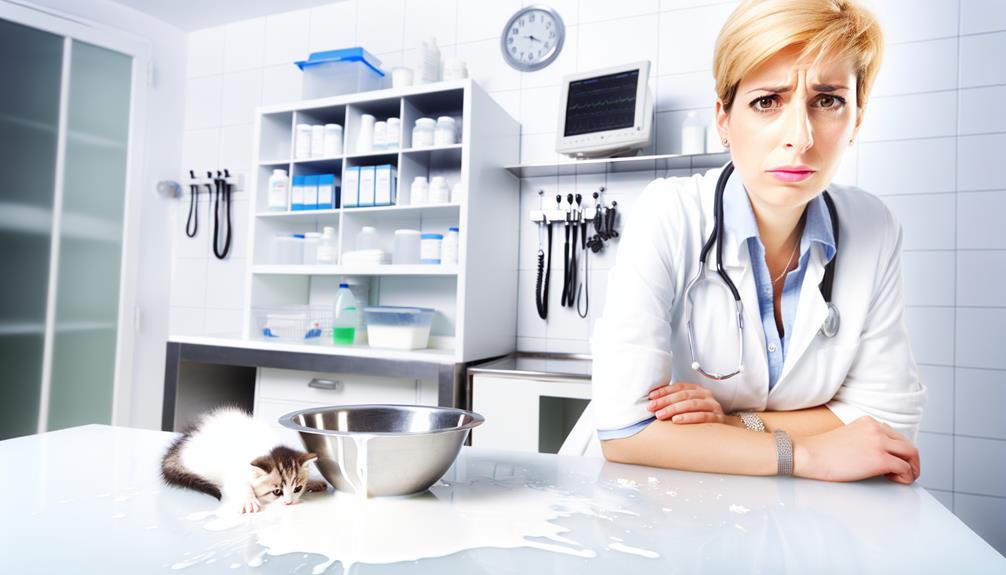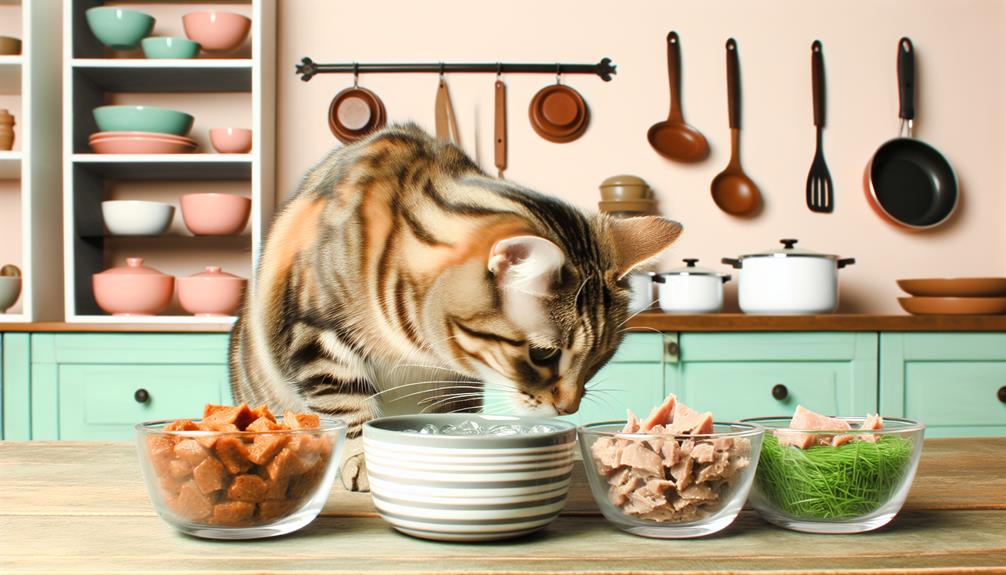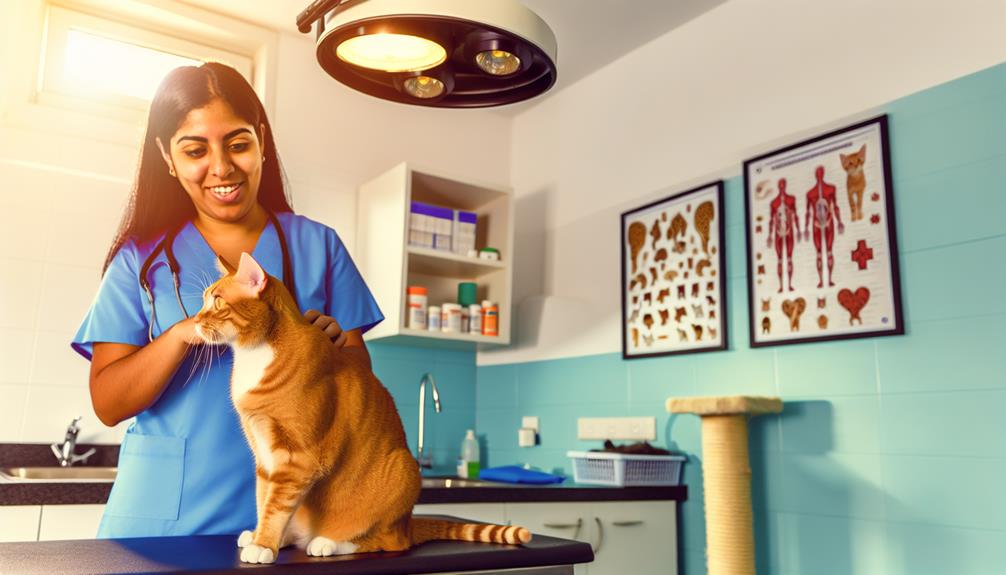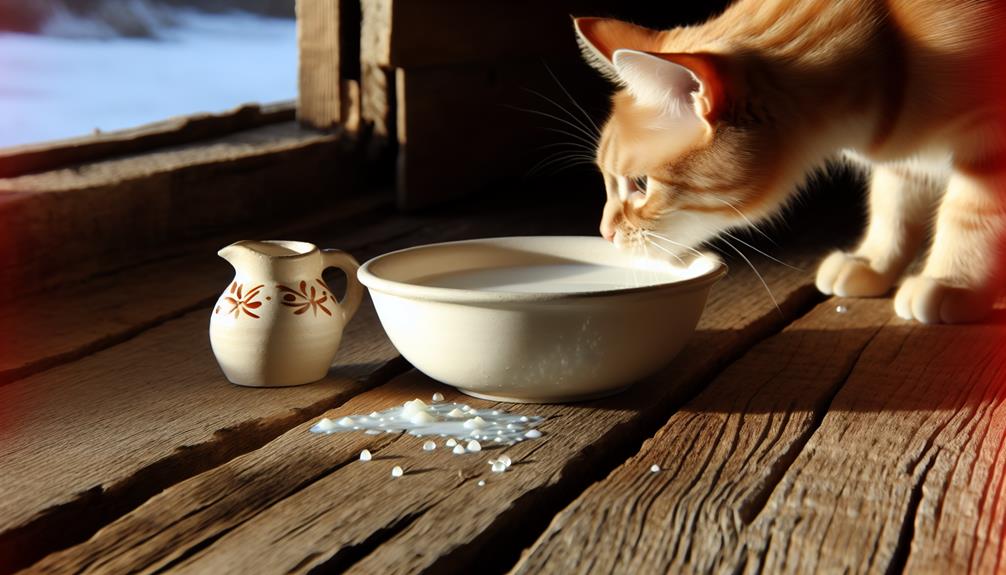You might picture a cat happily lapping up a bowl of milk, but have you ever wondered if it's actually good for them? Contrary to popular belief, most adult cats are lactose intolerant, meaning their bodies can't properly digest the lactose found in milk. This can lead to uncomfortable symptoms like diarrhea and bloating. So why does the image of milk-drinking cats persist, and what are the safe alternatives if you want to treat your feline friend? Let's explore the complexities behind this common misconception and discover what really keeps our cats healthy and content.
Historical Context
Throughout the centuries, cats and milk have been intertwined in popular culture, often depicted together in literature and art. This imagery has roots in various cultural beliefs and historical myths that have shaped our understanding of the feline diet. You might recall classic stories and artworks where a cat is contentedly lapping up milk, promoting the idea that milk is a natural and healthy choice for cats.
Historically, this association can be traced back to agricultural societies where dairy products were abundant. Farmers often left out milk for barn cats, which helped control rodent populations. This practice cemented the notion that milk was not only suitable but beneficial for cats. These cultural beliefs persisted, shaping public perception even as our understanding of feline biology evolved.
In various cultures, myths about cats and milk have been perpetuated and romanticized. For instance, in some European folklore, milk was considered a treat for household cats, symbolizing prosperity and care. You might find it interesting that such myths have been powerful enough to influence modern-day pet care practices, despite evidence to the contrary.
It's essential to recognize that these historical and cultural contexts have contributed to widespread misconceptions about what constitutes appropriate nutrition for cats. While these historical practices and cultural beliefs have a charming quality, they don't necessarily align with the scientific understanding of feline dietary needs.
Lactose Intolerance in Cats
When cats consume milk, they often exhibit symptoms of lactose intolerance, such as diarrhea, vomiting, and gas. These discomforts arise because many cats lack sufficient lactase, the enzyme required to digest lactose. Fortunately, there are safe alternatives like lactose-free milk and specially formulated cat milk that won't upset your pet's digestive system.
Common Symptoms Observed
Lactose intolerance in cats manifests through a variety of noticeable symptoms. Understanding these signs is vital, especially since milk myths have led many to mistakenly believe that cats thrive on milk. Observing cat behavior can provide critical clues to lactose intolerance.
When a cat consumes milk, the inability to properly digest lactose can lead to gastrointestinal distress. Here are the common symptoms you might observe:
- Diarrhea: One of the most frequent signs, diarrhea occurs because undigested lactose draws water into the intestines.
- Vomiting: Some cats may vomit shortly after drinking milk, indicating their digestive systems are rejecting the lactose.
- Flatulence: Increased gas is another sign, often accompanied by a bloated abdomen, which can be uncomfortable for your cat.
- Abdominal Pain: You may notice your cat acting unusually, such as being less active or more vocal, due to discomfort.
Recognizing these symptoms is essential for maintaining your cat's health. If you observe any of these behaviors after your cat consumes milk, it's likely they are lactose intolerant. Dispel the milk myths and prioritize your cat's well-being by monitoring their reactions closely.
Safe Alternatives Available
Exploring safe alternatives to milk is vital for cats with lactose intolerance. Cats often struggle to digest lactose, leading to gastrointestinal distress. Consequently, you should consider offering plant-based milks and homemade treats as substitutes.
Plant-based milks such as almond, soy, and oat milk are popular options. However, you must exercise caution. Almond milk is generally safe but should be unsweetened and given in moderation. Soy milk can be suitable but may cause allergies in some cats. Oat milk, low in allergens, can be a better choice, but always check for added sugars or artificial ingredients.
Homemade treats can also be an excellent alternative. Consider crafting simple recipes using cat-friendly ingredients like boiled chicken or fish. You might also blend pureed pumpkin or sweet potato with a splash of water for a nutritious snack. These alternatives not only avoid lactose but also provide essential nutrients.
When introducing any new food, monitor your cat for adverse reactions. Consulting a veterinarian before making significant dietary changes guarantees you're providing the best care possible. These safe alternatives can help maintain your cat's health and wellbeing, bypassing the complications of lactose intolerance.
Health Implications

When considering milk for your cat, it's vital to understand the potential health implications. Cats that are lactose intolerant may experience gastrointestinal distress, such as diarrhea and vomiting. Additionally, reliance on milk can lead to nutritional deficiencies, as it lacks essential nutrients found in a balanced cat diet.
Lactose Intolerance Effects
Over time, many cat owners have come to understand that feeding their feline companions milk might not be the best idea. Cats often face issues with lactose digestion due to a deficiency of lactase, the enzyme required to break down lactose. This can lead to several adverse health effects that you should be aware of, as it impacts overall feline nutrition.
When a lactose-intolerant cat consumes milk, it can experience various uncomfortable and potentially harmful symptoms. These symptoms include:
- Diarrhea: The undigested lactose can draw water into the intestines, resulting in loose stools and dehydration.
- Bloating: Gas production increases as bacteria in the gut ferment the undigested lactose, causing abdominal discomfort.
- Vomiting: Some cats may react more severely, expelling the milk and other stomach contents.
- Flatulence: Excessive gas can lead to frequent and often foul-smelling flatulence.
These symptoms can lead to more significant health issues if not addressed promptly. It's critical to recognize that providing milk as a treat or dietary supplement doesn't enhance your cat's nutrition and may, in fact, compromise its well-being. Consequently, it's advisable to seek suitable alternatives to guarantee your cat remains healthy and comfortable.
Nutritional Deficiency Concerns
Given the potential for lactose intolerance, providing milk to your cat can result in nutritional deficiencies that compromise its overall health. Cats require specific nutrients that milk does not adequately supply, leading to imbalances that can affect their well-being. One primary concern is the insufficient provision of essential vitamins and minerals, as milk lacks the thorough nutrient profile needed for feline health.
Nutrient Comparison
| Nutrient | Milk (Inadequate Source) | Appropriate Sources |
|---|---|---|
| Calcium | Limited in milk | Commercial cat food, fish |
| Hydration | May cause dehydration | Fresh water, wet cat food |
| Proteins | Low-quality proteins | Meat, specialized cat food |
| Vitamins | Lacks essential vitamins | Balanced cat diet, supplements |
Additionally, milk doesn't meet your cat's hydration needs. In fact, it can cause dehydration due to gastrointestinal upset, leading to further health complications. For ideal hydration, always provide fresh water and consider wet cat food as an alternative.
Signs of Lactose Intolerance
Lactose intolerance in cats manifests through a variety of clinical signs, which can often be distressing for both the pet and the owner. In feline biology, the ability to perform efficient milk digestion diminishes as cats mature. This is primarily due to a significant reduction in the enzyme lactase, which is essential for breaking down lactose—a sugar found in milk. When a cat's digestive system can't properly process lactose, it leads to several noticeable symptoms.
Signs of Lactose Intolerance
- Diarrhea: One of the most common indicators of lactose intolerance is diarrhea. The undigested lactose in the intestines draws water into the bowel, leading to loose, watery stools. This can cause dehydration if not addressed promptly.
- Vomiting: Cats may also vomit after consuming milk. This happens because the undigested lactose can irritate the stomach lining, causing discomfort and leading to regurgitation.
- Abdominal Pain and Bloating: You might notice your cat exhibiting signs of abdominal discomfort, such as restlessness, crying, or a distended abdomen. This is due to gas buildup from fermenting lactose in the intestines.
- Flatulence: Increased gas production is another symptom to watch for. The fermentation process of undigested lactose by intestinal bacteria produces gases, which can result in noticeable flatulence.
Recognizing these signs is essential for ensuring your cat's well-being. Monitoring their reaction to milk and other dairy products can help you prevent these uncomfortable symptoms. If you notice any of these signs, it's advisable to consult with a veterinarian for further guidance and to explore suitable dietary adjustments.
Alternative Treats

When your cat can't tolerate milk, it's vital to seek out alternative treats that won't upset their digestive system. Cats are obligate carnivores, meaning they require a diet high in animal protein. Consequently, it's important to choose treats that align with their nutritional needs.
Homemade treats can be a great option. You can prepare simple, protein-rich snacks using ingredients like cooked chicken, turkey, or fish. Make sure the meat is plain, without added seasonings or sauces, as these can be harmful to cats. Small pieces of cooked liver can also be a nutritious treat, but should be given sparingly due to its high vitamin A content.
Commercial options are also available and often formulated to meet a cat's dietary requirements. There are numerous cat treats on the market that are specifically designed to be low in lactose and high in protein. When selecting commercial treats, look for products that list meat as the first ingredient and avoid those with excessive fillers, artificial flavors, or preservatives. Reading the ingredient list and nutritional information is paramount to confirm you're providing a healthy snack.
It's also possible to find treats that cater to specific health needs, such as dental treats that help reduce plaque buildup or hypoallergenic options for cats with food sensitivities. Always introduce new treats gradually and monitor your cat for any adverse reactions.
Safe Dairy Options
For cats that enjoy dairy but cannot tolerate regular cow's milk, there are safe dairy options available that can satisfy their cravings without causing digestive distress. These alternatives can cater to your cat's preferences while ensuring they remain healthy and comfortable.
- Lactose-Free Milk: One of the most straightforward dairy sources is lactose-free milk specifically formulated for cats. This milk retains the taste and nutrients but removes lactose, making it easier for your cat to digest.
- Yogurt: Plain, unsweetened yogurt can be a viable option. The live cultures in yogurt help break down lactose, which can be beneficial for cats. However, always offer it in small quantities and monitor your cat's reaction.
- Cheese: Certain types of cheese, like cheddar or Swiss, have lower lactose content and can be tolerated by some cats. Cheese should be given sparingly, as it's high in fat and calories.
- Cat-Specific Dairy Products: Several manufacturers produce dairy products intended for feline consumption. These products are formulated to be safe and digestible for cats, aligning well with their dietary needs and preferences.
When introducing any new dairy source to your cat, it's important to do so gradually. Start with small amounts and observe your cat for any signs of gastrointestinal distress, such as diarrhea or vomiting. Not all cats will share the same preferences, and individual tolerance levels can vary.
Consulting Your Vet

Wondering whether it's safe to introduce dairy products into your cat's diet? Consulting your vet is the most reliable way to get an accurate answer. Veterinarians have the expertise to provide tailored dietary advice based on your cat's specific health needs, age, and lifestyle. Vet recommendations are important because not all cats have the same tolerance to lactose or other elements found in dairy products.
When you visit your vet, come prepared with detailed observations about your cat's current diet and any past experiences with dairy. This information helps your vet make informed recommendations that consider potential allergies, intolerances, and overall nutritional balance. Dietary advice from a vet is particularly significant if your cat has pre-existing health conditions such as kidney disease, gastrointestinal issues, or diabetes, as these can be exacerbated by inappropriate food choices.
During the consultation, your vet may suggest specific dairy options that are easier for cats to digest, such as lactose-free milk or specialized cat milk available in pet stores. They'll also advise on the proper quantities to avoid overfeeding and potential digestive upset. Vet recommendations often emphasize moderation, stressing that even safe dairy products should only supplement a balanced diet, not replace it.
Conclusion
While the image of cats lapping up milk might bring to mind nostalgic scenes from classic cartoons, it's safer to stick to alternatives. Most cats are lactose intolerant, and giving them regular milk can lead to unwanted health issues. Instead, opt for lactose-free milk or specialized cat dairy products. Always consult your vet before introducing new treats into your cat's diet. Remember, a healthy cat is a happy cat, free from digestive woes.
